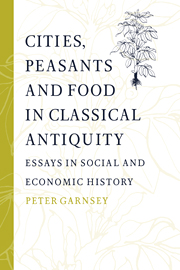Book contents
- Frontmatter
- Contents
- Preface
- Editor's preface
- Acknowledgements
- List of abbreviations
- PART I CITIES
- PART II PEASANTS
- 6 Peasants in ancient Roman society
- 7 Where did Italian peasants live?
- 8 Non-slave labour in the Roman world
- 9 Prolegomenon to a study of the land in the later Roman empire
- 10 Mountain economies in southern Europe
- PART III FOOD
- Bibliography
- Index
8 - Non-slave labour in the Roman world
Published online by Cambridge University Press: 02 December 2009
- Frontmatter
- Contents
- Preface
- Editor's preface
- Acknowledgements
- List of abbreviations
- PART I CITIES
- PART II PEASANTS
- 6 Peasants in ancient Roman society
- 7 Where did Italian peasants live?
- 8 Non-slave labour in the Roman world
- 9 Prolegomenon to a study of the land in the later Roman empire
- 10 Mountain economies in southern Europe
- PART III FOOD
- Bibliography
- Index
Summary
The Roman lawyer Gaius wrote that the fundamental social division was that between slave and free (Inst. 1.9). This doctrine is unexceptionable, but it does not advance us far towards an understanding of the structure of society or the character of the labour force. Moreover, it must not be taken to imply that the slave-free division was clear-cut. Among workers there were numerous groups or categories of those whose positions, defined not in purely juridical terms, but in terms of obligations, privileges and degree of subjection to another's power, fell somewhere between the chattel slaves of the ranches and mines and the free peasant proprietors and self-employed artisans. For present purposes we may relegate to the back-ground those intermediate groups whose situations were not significantly better than those of the bulk of the servile labour force: for example, the tied coloni of the late empire (described as servi glebae in Cod.Iust. 11.52.1), and debt bondsmen, who existed in every period, not least the late Republic (Varro, Rust. 1.17.2) and early Empire (Columella, Rust. 1.3.12).
The classification of some groups of workers is by no means a straightforward procedure. Finley, reviving a thesis of Fustel de Coulanges, has suggested that a significant proportion of the free tenant-farmers of the Principate (and late Republic) were de facto bondsmen. Again, the position of the freedmen, an important element in the urban labour force, was ambiguous.
- Type
- Chapter
- Information
- Cities, Peasants and Food in Classical AntiquityEssays in Social and Economic History, pp. 134 - 150Publisher: Cambridge University PressPrint publication year: 1998
- 2
- Cited by



